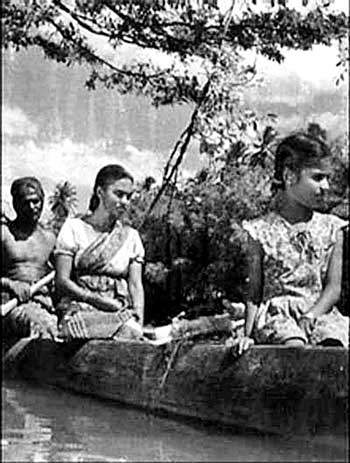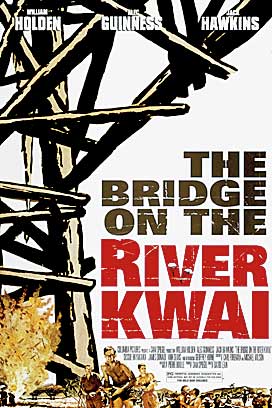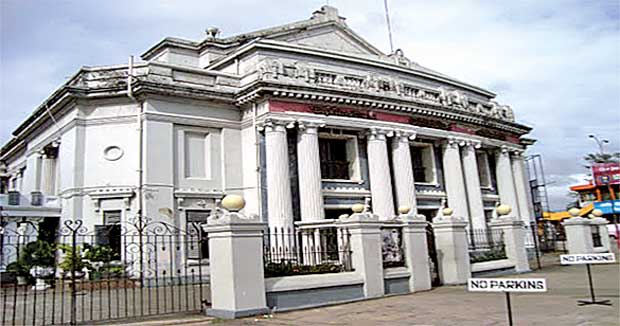Reply To:
Name - Reply Comment
By D. B. S. Jeyaraj
“Rekava”(line of Destiny) directed by Lester James Peris premiered 60 years ago at the Regal Theatre in Colombo on December 28th 1956. It was a path-breaking venture in Sinhala cinema that notched many “firsts”. Among these was the singular honour of being the first Sinhala film to compete for the Palme d’Or best film award at the prestigious Cannes Film festival in France. Rekava was screened by invitation at the 10th film festival held in Cannes from May 2 -17, 1957. Rekava dubbed in English as “line of destiny” did not win but Lester James Peries won significant fame for Sri Lanka known as Ceylon then by placing Sinhala cinema on the global movie map for the first time.

Though Rekava is acknowledged widely as a pioneering venture with many firsts to its credit, not all the laurels heaped upon it are totally accurate. For instance it is stated by many that Rekava was the first Sinhala film to be shot outside studios entirely on location and that dialogues were recorded on the spot. It is also said that Rekava was the first Sinhala movie to be filmed in Sri Lanka alone. Both these assertions are only partially correct.
The first Sinhala film to be shot on locations entirely outside a studio was “Gambada Sundari”made in 1950 by Prasad Studios productions and directed by George S.Wijegunaratne. The film was first shot on 16 mm film using an Auricon ‘sound on film’ camera which recorded sound optically on film. The 16 mm film was later blown up to 35 mm and screened on January 27, 1950 at Crown theatre in Colombo. Cinematography was by Leslie Pedris while music was composed by N.K.Kariyawasam. The main actors were Sheela Peiris, Kingsley Jayasekara and E.C. Bulathsinhala.The film was shown along with a documentary in colour on the Esala perahera. It appears that only one 35mm copy of the film was made which of course is now unavailable.

Another point made in praise of Rekava is that the film was the first movie to be filmed entirely in Sri Lanka. Earlier Sinhala films were either wholly or partially shot in India. While Rekava was definitely shot entirely in Sri Lanka. It was certainly not the first movie to be so filmed. The first Sinhala movie to be filmed completely in Sri Lanka was “Banda Nagarayata Pemineema” (Banda comes to town) produced in 1952 by S.M.Nayagam. It was Nayagam who made cinematic history by producing the first Sinhala “talkie” Kadawunu Poronduwa (Broken Promise) in 1947.
S.M.Nayagam who had filmed Broken Promise and other films through his production company Chitrakala Movietone at his studio in Madurai in India had later acquired land in Kandana and constructed the Sri Murugan Nava Kala studio which later became known as SPM studios. “Banda Comes to Town” was the first film made by Nayagam in his Kandana studio. It was directed by Raja Wahab Kashmiri an Indian national. It was co-directed by A.B. Raj, the father of popular Tamil Nadu actress Saranya who excels in maternal roles. Among the actors were Bernard Perera, Hugo Fernando, Joseph Seneviratne, Nanda Leelanayake and Malini Ranasinghe. The film was released on May 4, 1952 at the Elphinstone in Colombo and other outstation theatres.
Theme, content, style and impact
It could be seen therefore that Rekava was neither the first Sinhala film to be shot outside studios on location nor the first to be filmed entirely in Sri Lanka. It was however the first Sinhala feature film to be both shot on location outside studios and filmed entirely in the Island. More important than these technicalities was the contribution made by Rekava to enhance Sinhala cinema and take it in a new direction via theme, content, style and impact. Moreover, Rekava brought fame to the then Ceylon by becoming the first Sinhala film to compete by invitation at the famous Cannes film festival. The road to Cannes for Rekava was an arduous and hectic journey worthy of re-relating 60 years later.
As stated earlier there were two locations for filming Rekava, one in the up country and the other in the low country. Shooting began first at a location in Bandarawela. W.T. Keble, the legendary founding headmaster of St. Thomas’ Prep school in Kollupitiya was later the founder - headmaster of St. Thomas’ School in Bandarawela as well. Keble persuaded Lester James Peris to film in Bandarawela, guaranteeing that there would be no rain during that period on the basis of statistics compiled by him for the past 20 years. Statistics indicated there was no rainfall during the specified period for the past eight years. So the film unit went to Bandarawela.

There were only two boarding houses in the area. The entire unit was housed there amidst cramped conditions. Meals were supplied from a Chinese restaurant. The surroundings were scenic with a long winding road, grasslands, striking trees and a mountain in the backdrop. Shooting began and the opening sequences were filmed.
Scenes of Sena and his friends and the virindhu song sung by Ivor Dennis for the stilt walker Miguel played by Sesha Palihakkara and the antics of his monkey were filmed to a great extent in the first few days. And then it began raining, raining, raining! It rained consecutively for 22 days!
Days passed and nothing could be done. Keble who had guaranteed it would not rain avoided Lester in embarrassment. Making matters worse was the behaviour of the monkey that accompanied the stilt walker and performed tricks. The monkey trainer got one bottle of arrack and gave the monkey half-a-bottle each day. Denied its daily quota due to rain, the monkey threw tantrums, biting crew members and defecating in the Bug Fiat car used for transporting it. As the pouring rain continued without abating, Lester thought of utilizing the opportunity by shooting the final sequence that required heavy rainfall. So the cast needed for the final sequences including Winston Serasinghe were brought to Bandarawela for filming in the rain. What happened next was that the rains suddenly ceased and the sun began shining brightly, making the cast brought for the rain sequence redundant. According to Lester, the Chinese restaurant proprietor had chortled, “Lain, lain no shooting; sun, sun no shooting.” The weather gods had a hearty laugh at the expense of Chitra Lanka. The unit shot a few sunny scenes and returned after wasting more than 20 days.
Wewala village close to Alawwa
The second location chosen was a village called Wewala close to Alawwa. Lester was familiar with the place having filmed some scenes there earlier for the GFU. The crew and cast went to Wewala  and lived there with the villagers in village homes. Lester, Willie and Titus shared one small room in a local house. The young men in the crew and cast were under strict orders not to have any “romances” with the village damsels. This was adhered to. So much so that when the shooting ended, an elderly village woman was to “complain” that the crew was departing after staying in the village for nine months without leaving a single “memento” behind
and lived there with the villagers in village homes. Lester, Willie and Titus shared one small room in a local house. The young men in the crew and cast were under strict orders not to have any “romances” with the village damsels. This was adhered to. So much so that when the shooting ended, an elderly village woman was to “complain” that the crew was departing after staying in the village for nine months without leaving a single “memento” behind
The unit spent more than eight months shooting at Wewala and nearby places. The shooting schedule went awry when a chicken pox epidemic erupted, afflicting the villagers and the cast and crew including Lester. Many in the village became critical grumbling that the “bioscope karayas” had brought a curse upon the village just as the villagers in the film story accused the boy Sena of bringing bad luck to the village. Two whole months of shooting were lost due to chicken pox.
Since this was Lester’s first attempt at making a feature and because the concept of location shooting was something novel, the film making became a trial and error exercise. The weather was fine most of the time in Wewala but the problem was the overwhelming presence of crows and the sounds they made. The mikes picked up all outside sound. The track had to be transferred regularly from magnetic to optical and sent to India for processing. A sound recording technician from Madras (now Chennai) N.B.S. Mani had been enlisted. There was no post-synching facility on location in those days. Thus Lester could not take any chances and had to shoot more than 120,000 feet of film. Nowadays of course celluloid has given way to the digital image.
Another remarkable feature of Rekava was the music score and songs. When Lester was living in London he had heard the Lankan singer Hubert Rajapaksa sing Sunil Santa’s immortal composition ‘Olu Pipila’ in a concert held at the Wigmore hall. This was in 1949. The song had a great impact on the young Lankan living in London. Years later, Lester was to recount the experience to writer-director Tissa Abeysekara.” It was a call from home and something responded from deep within my conscience” said Lester to Tissa.
Sunil Santha’s “Olu Pipila”
After listening to the “Olu Pipila” rendition by Hubert Rajapaksa at Wigmore Hall the highly impressed Lester had inquired about the song and was told that the composition was by Sunil Santa.
Apparently Lester resolved then that he must get hold of Sunil Santa if and when he made a film. So when Lester embarked upon Rekava it was Sunil Santa that he approached to compose the music. Catholic Priest, Rev. Fr. Marceline Jayakody, also known as the ‘Pansale Piyathuma’, wrote the lyrics. Sunil Santha refused at first to compose music for a film. Lester enlisted Fr. Jayakody in his effort to make Sunil agree. Finally Sunil Santha consented with some conditions. He composed the melodies and musical score but got music director B.S. Perera to conduct the orchestra with K.A. Dayaratne as the music arranger.
The singers were Indrani Wijebandara, Sisira Senarathne, Latha Walpola, Ivor Dennis and Tilakasiri Fernando. Subsequently Indrani and Sisira got married. The song sequences in Rekava are fabulous thanks to the lyrics of Fr. Marceline Jayakody, the music of Sunil Shantha and the renditions by the respective singers. The picturisation of songs by Lester was enhanced by the striking camera work of Wille Blake. ‘Olu Nelum Neriya Rangala’ (Sisira), ‘Sudu Sanda Eliye’ (Indrani), ‘Mini Muthu’ (Tilakasiri), ‘Sigiri Landakage’ (Latha), ‘Anurapura Polonnaruwe’ (Ivor) and ‘Wesak Kekulu’ (Indrani) were all great hits.
So too was the classic theme music composed for the showing of titles and opening scenes. Willie Blake brought out the pastoral beauty of the rural hinterland through his expressive cinematography and one cannot but help recalling Mahatma Gandhi’s saying about ‘India living in her villages’.
There was also the striking contrast between the songs ‘Olu Nelum’ by Sisira and ‘Mini Muthu’ by Tilakasiri and the manner of picturisation. ‘Olu Nelum’ is a joyful song brimming with the zest for life as the boatman goes along with the flow of water against a background of scenic loveliness. ‘Mini Muthu’ on the other hand is a sorrowful song with melancholy tones set against a bleak desolate landscape caused by the drought. The virindhu song by Ivor Dennis picturised on Sesha Palihakkara and the children is another number lingering in memory. Thanks to YouTube one is able to view and hear these songs again and again.
One of the difficulties Lester had in filming Rekava was to make the actors influenced heavily by the stage and melodramatic films break out from that mould and act naturally. They were asked to speak normally as in everyday life instead of adopting stylized diction and intonation along with sweeping mannerisms. As shooting progressed, more and more colloquial speech was introduced into the script written by K. A.W. Perera on the instructions of Lester. Actors were also made to adopt silence at times and convey emotions through expressions or lack of expressions. Ironically the problem of sound recording on location compelled Lester to ask actors to speak out aloud at times.
Thespian Gamini Fonseka’s entry
At one stage, Chitra Lanka exceeded the budget allocated for Rekava. Additional finance was procured from Ceylon Theatres who distributed the film after Sir Chittambalam Gardiner and Lady Gardiner viewed some of the reels. The main editing was done in Sirisena Wimalaweera’s Navajeewana studio in Kiribathgoda by Titus Thotawatte, who is credited in the film as Editor under his original name Titus de Silva. Titus however served in many capacities as an assistant director. Incidentally, the great thespian Gamini Fonseka’s entry into the film world was also through Rekava.
Sinhala cinema’s first super star Gamini Fonseka made his screen debut in Rekava. It was Lester James Peries who gave Gamini his first break in movies through his path-breaking film. Gamini showed his face for the first time on screen in a scene in the film. He was working as a camera cum production assistant then for Lester. The man who introduced Gamini to Lester was Premnath Moraes, the man of multiple talents. Premnath Moraes was a journalist, writer, poet, lyricist, actor, director, commentator and a silver-tongued orator. He had worked with Lester on ‘Rekava’ and later quit but maintained friendly relations with the director. It was Premnath who sent Gamini Fonseka to Lester James Peries with a letter of introduction.
Responding positively to Premnath’s recommendation, Lester took Gamini on as a camera assistant to ace cinematographer Willie Blake. ‘Rekava’ was being filmed then. It was being shot at Wewala near Alawwa. Gamini stayed with Justin, another camera assistant. Shooting went on for six days a week. Only Sunday was rest day. On Saturdays, Justin went to Ja-ela and brought pork. Gamini and Justin cooked it and entertained the trio of Lester, Willie and Editor Titus for a spirited dinner.
Despite the Saturday night bonhomie over a pork dinner, Willie Blake and Gamini Fonseka did not hit it off well while working. The quick-tempered Blake would lose his cool frequently. The youthful Gamini would not take the outbursts lightly. There were regular verbal duels. After about a month, Gamini thought of calling it quits and informed Lester. By now the director had realised Gamini’s potential and did not want to let go of him.
Lester sounded out the production manager, Dan Dorairaj who was more than happy to take Gamini on board. So now Gamini was a production assistant. His chief responsibility was to ferry the artistes and crew from wherever they were staying to the shooting location in the morning and bring them back in the evening. While doing so, Gamini also assisted both the director and editor at times.
It was while the film was being shot that Gamini Fonseka got a chance to be an actor. According to the script, the boy Sena played by Somapala Dharmapriya was said to have healing powers. There were scenes where afflicted people came to be cured. Due to some reason Gamini had not shaven for a few days and had stubble. Deciding to shave it off on location, Gamini hung a small mirror on a tree and took out a razor when Lester passing by told him not to shave.“ Gamini, don’t shave today. We have to shoot sick patients and with that growth you look like a sick man,” Lester said. Thus Gamini faced the camera for the first time as a patient with a towel around his neck seeking a cure from Sena. Later in another shot he was a part of a crowd but the camera did not focus on him.
David Lean’s “Bridge on the River Kwai”
While ‘Rekava’ was being filmed, there arrived in the island, David Lean to film the classic ‘Bridge on the River Kwai’. Lester met and interacted with the illustrious filmmaker through the good offices of Sarath Wijesinha, the premier financier of ‘Rekava’. When the shooting of ‘Rekava’ ended, four crew members got an opportunity to work for David Lean thanks to being recommended by Lester.
They were Dan Dorairaj, Sesha Palihakkara, Wijaya Abeydeva and Gamini Fonseka. Dorairaj was taken into the Transport Dept. while Palihakkara was put in the makeup section. Abeydeva and Fonseka were assigned to the local assistant directors dept. All four were provided with accommodation, transport, food and a daily stipend while shooting went on in Kitulgala. The stint at Kitulgala made possible by Lester was a tremendous experience for Gamini. He moved easily with the Western personnel and established firm friendships with some.
Interestingly enough, the famous director Sir David Lean who arrived in Sri Lanka to shoot ‘Bridge on the River Kwai’ was the man who helped Lester shoot the rain scenes for Rekava. When the making of Rekava was in progress, Lester had a dinner meeting with Lean at the Chinese Dragon cafe in Colombo. While conversing, Lester told David Lean that he was waiting for rain to shoot the final sequences. The British Director had laughed out loud, telling Lester not to wait for rain but to go ahead and make rain with the help of the Fire Brigade. Lean also delegated one of his special effects assistants to help out. The services of the Colombo Fire Brigade were obtained. Since large volumes of water were required, the rain scene was shot in an estate belonging to J.R. Jayawardene in Kelaniya adjoining the Kelani Ganga. The fire engines pumped in the water from the river and sprayed it upwards to a height of over 60 feet using a special kind of nozzle called the London nozzle. About half-a-dozen cars flashed their headlights constantly to provide light as the shooting went on from midnight to dawn. The monsoon rain sequence was very well shown in Rekava and forms an integral component of the film narrative.

Elphinstone and Roxy Theatres
As stated earlier, Rekava premiered to an invited audience at Regal Cinema on December 28, 1956. Thereafter it was screened in 16 theatres, including Elphinstone and Roxy Theatres in Colombo. The initial reviews particularly in the English media were complimentary. The film evoked great expectations and ran well for the first week. Audiences began to dwindle from in the second week and drop drastically in the third week. Rekava had flopped financially.The public mood had changed soon as this realistic film disappointed fans used to seeing melodramatic films of the formula variety. Also sections of the Sinhala media turned hostile to Rekava and conducted an anti-Rekava campaign.
Apparently there were two reasons for this. It was Regi Siriwardena who told me about these matters vividly in a lengthy conversation many years ago at the International Centre for Ethnic Studies (ICES) where both of us were working at that time. What Regi said in essence was this: Though Rekava was shot in a village and depicted rural life realistically, the film went against the popular romanticisation of the village and shattered illusions about rural innocence and purity. Rekava showed attributes of deceit, selfishness and cunning among village characters. It also demonstrated the extent of superstition and irrationality prevalent. This went against the popular conceptualization of the village and village life. Thus sections of the Sinhala media turned against Lester saying he was Westernized and a Catholic, who could not comprehend the sanctity of “apey gama”. The second reason for hostility according to Regi was the caste factor. Hard as it is to believe in the current context, a groundswell of resentment had gained ground then in certain quarters on account of caste. A horrible whisper campaign gathered momentum that Rekawa was a Karawe caste conspiracy. It was pointed out that a number of people involved in the film like Lester, Christopher Peries, Rev. Fr. Marceline Jayakody, Sunil Santha, Romulus de Silva etc., were of that caste. It was even alleged that Rekawa and Karawe had the same six letters from the alphabet, which indicated a hidden meaning.
Interestingly, Lester in an interview given to Kumar de Silva alludes to this by relating an anecdote where Winston Serasinghe (not a Karawe) was faulted by friends at CR and FC for getting trapped into a ‘Kay’ conspiracy.
The end result of these hostile campaigns and the sense of disappointment felt by audiences used to a different type of cinema resulted in Rekava becoming a financial flop in its initial run. Lester himself tells the story of how he went incognito to Elphinstone to see audience reactions. The film goers were very angry at the unconventional film and one was heard to remark that instead of wasting money for this cinema ticket “bread could have been bought and given to crows”.
Austrian-born German Filmstar Maria Schell
What really helped Rekava, was an unexpected windfall. Austrian-born German film actress Maria Schell (sister of Oscar winner Maximilan Schell) was in Colombo for a vacation at the time Rekava was screened. She was staying at the Mt. Lavinia Hotel. Maria had wanted to see a Sinhala film and  her guide had taken her to see Rekava at the Roxy. Maria loved the film and said so in an interview to the ‘Observer’. She stated in the interview that she would recommend Rekava to be screened at the prestigious Cannes film festival. Maria Schell kept her word and soon there was an invitation from the Cannes festival organizers. There was once again a hitch. Opposition built up that a negative film like Rekava portraying the villages of the country in a bad light should not be allowed to go to Cannes. The Education and Cultural Affairs Minister of the time Dr. W. Dahanayke said: “You cannot send a film like Rekava where there are bad people. You must make films where village people are shown as paragons of virtue and can do no wrong.”
her guide had taken her to see Rekava at the Roxy. Maria loved the film and said so in an interview to the ‘Observer’. She stated in the interview that she would recommend Rekava to be screened at the prestigious Cannes film festival. Maria Schell kept her word and soon there was an invitation from the Cannes festival organizers. There was once again a hitch. Opposition built up that a negative film like Rekava portraying the villages of the country in a bad light should not be allowed to go to Cannes. The Education and Cultural Affairs Minister of the time Dr. W. Dahanayke said: “You cannot send a film like Rekava where there are bad people. You must make films where village people are shown as paragons of virtue and can do no wrong.”
Fortunately for Lester, Paul Bowles, a celebrated American author and composer was in the island at that time and wrote to the Minister criticising him on account of blocking Rekava. Bowles wrote that it was unbelievable that the Minister thought Western audiences were naïve to believe that everybody was good in the villages.
The Government relented and Rekava went to Cannes. The good Samaritans who made this happen were two Westerners whom Lester had never met. Both Maria Schell and Paul Bowles had been impressed by the film and had no connection to Lester personally. It was their action that helped Rekava to go to Cannes.
10th Cannes Film Festival in May 1957
Lester along with Titus went first to London and edited the film again with sub -titles. The length was whittled down to 89 minutes.Thereafter they went to France with Rekava to screen the film at the 10th Cannes film festival in May 1957. The films screened for the best feature film competition were – The Bachelor Party by Delbert Mann, Betrogen bis zum jüngsten Tag by Kurt Jung-Alsen, La Casa del ángel by Leopoldo Torre Nilsson, Celui qui doit mourir by Jules Dassin, Dolina miru by France Štiglic, Don Kikhot by Grigori Kozintsev, Elokuu by Matti Kassila, Faustina by José Luis Sáenz de Heredia, Friendly Persuasion by William Wyler, Funny Face by Stanley Donen, Gotoma the Buddha by Rajbans Khanna, Guendalina by Alberto Lattuada, High Tide at Noon by Philip Leacock, Ila Ayn by Georges Nasser, Kanał by Andrzej Wajda, Kome by Tadashi Imai, Két vallomás by Márton Keleti, La ‘Moara cu noroc’ by Victor Iliu, Le notti di Cabiria by Federico Fellini, Qivitoq by Erik Balling, Rekava by Lester James Peries, Rose Bernd by Wolfgang Staudte, Same Jakki by Per Høst, Shiroi sanmyaku by Sadao Imamura, Sissi – Die junge Kaiserin by Ernst Marischka, Det sjunde inseglet by Ingmar Bergman, Sorok pervyy by Grigori Chukhrai, Un condamné à mort s’est échappé ou Le vent souffle où il veut by Robert Bresson, Yangtse Incident by Michael Anderson, Zemya by Zahari Zhandov and Ztracenci by Miloš Makovec.
The Jury at the 10th Cannes Festival were André Maurois (France) (president)Jean Cocteau (France) (honorary president), Maurice Genevoix (France), Georges Huisman (France) (historian), Maurice Lehmann (France), Marcel Pagnol (France),Michael Powell (UK),Jules Romains (France), Dolores del Río (Mexico), George Stevens (USA)and Vladimir Volchek (Czechoslovakia) Despite the participation of trail blazing directors like Ingmar Bergman, Federico Felleni, Robert Bresson, Sadao Imamura, Stanley Donen and by Andrzej Wajda the coveted Palme d’Or went to “Friendly Persuasion” made by American filmmaker William Wyler in a highly contested controversial decision. The Special Jury prize was jointly awarded to Sweden’s Ingmar Bergman for “The Seventh seal” and Poland’s Andrzej Wajda for “Kanal”. The best director award was won by Robert Bresson of France for “A man escaped”.
Rekava, the first Sri Lankan film to be shown at Cannes, did not win any award but for Lester – down in the doldrums after the film flopped – it was a morale booster. The film was received well and exhibitors bought screen rights for the Soviet Union, Poland, Germany, France and Britain.This international recognition had a positive impact back home. The film was again screened at outstation theatres for few days at a time. Those days it was customary for cinema theatres to screen old Sinhala and Tamil films between the screening of new films. There were some theatres which screened only old films for two days at a time. Rekava got gradually popularised in this way. I too saw Rekava on screen for the first time at a theatre in Kurunegala in my early twenties.
Rekava is now celebrated as one of Lester’s three best films along with Gamperaliya and Nidhanaya. Lester James Peries with his Rekava is seen as a path-breaker in Sinhala cinema as Ediriweera Sarachchandra is seen with Maname in Sinhala drama. Rekava and Maname were screened and staged in the watershed year of 1956.
Lester-Sumitra Line of Destiny
As stated earlier, the fate of Rekava and its maker may have been different if not for the chance for the film to be screened at the Cannes festival. It was that recognition which paved the way for a Rekava renaissance. Cannes proved to be the line of destiny in Lester’s life in another sense too. It was enroute to Cannes via Paris that Lester met his wife Sumitra Peries nee Gunawardena for the first time in the city of light. The couple who married in 1964 celebrated their golden anniversary in 2014. That truly was for Lester and Sumitra their line of destiny!
D.B.S. Jeyaraj can be reached at [email protected]